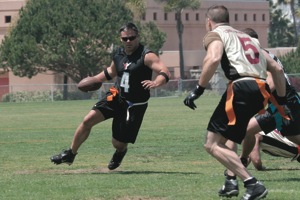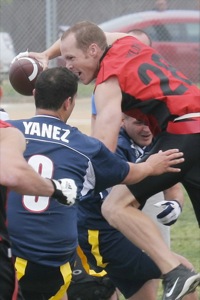-
- Connecticut’s civil unions law heads to court in a battle with implications for entire United States
- Television evangelist Falwell dies at 73
- Connecticut lawmakers pull same-sex marriage bill days before high court case
- Presidential hopeful Brownback addresses state GOP convention
- Idaho school’s ‘unisex’ restroom sparks debate
- National News Briefs
- World News Briefs
health & sports
Out on the Field
Gridiron passion
Published Thursday, 17-May-2007 in issue 1012
When Julio Montano steps into his Chargers huddle, his blood is pumping. “It’s an adrenaline rush,” he says. His players are there together, listening as he calls a play from a playbook he and his teammates have memorized. Montano has to be decisive. He has to think ahead two or three plays, softening up his opponent for the big blow that will score a touchdown. In this way, football becomes a chess match on grass, but with bigger pieces.
The Chargers of the San Diego American Flag Football League (SDAFFL) mimic the NFL franchise of the same name. They both have high-powered offenses and a good defense. When Montano’s offense runs a play, however, it isn’t ended by a tackle. A whistle blows a play dead when a defender pulls a flag from the belt clip of the ball carrier. For Montano’s first-place Chargers, that usually happens after a completed pass for plus yardage.
With Montano as the quarterback, the Chargers have scored 141 points through just five games. They don’t score on every possession, but Montano says in order for his team to lose, that’s just what the opposing team will need to do. So far no one has. The Chargers are currently the only undefeated team in this, the fourth season of the SDAFFL.
The league started when Ivan Solis gathered a bunch of friends to throw the football around at Balboa Park in the Fall of 2002. In the five years since then, the SDAFFL has become what it calls the largest flag football league of its kind in the Western United States. The league now has eight teams and nearly 120 active players, making this season the largest in the league’s short history.
While the rules of flag football are simple, they are a far cry from those neighborhood street games some of us played as kids, where streetlamps marked the end zone, sidewalks were out of bounds, and the only time-outs you got were for passing cars driving down the field of play.
In flag football, the field is not a mid-city cul-de-sac, it’s a grass field that measures 80 yards from goal-line to goal-line, and is marked off every 10. It’s 35 yards from sideline to sideline. Each team has four downs to move the ball at least 10 yards, whereupon another four downs are granted. It is a game built on offense, and specifically the pass. Only getting the ball into the end zone for a touchdown will score any points. There are no field-goals.
Each team creates its own book of plays, which for the Chargers is the responsibility of head coach Abe Velarde. He also calls the defensive plays for his crew, which consists of choosing between man and zone coverage. According to the statistics, Velarde handles both responsibilities well. His offense ranks toward the top in total points scored, while his defense is the stingiest in the league, yielding only 101 points through five games this season.
After the kick-off and the start of a possession, both teams will put seven players on the field. On offense, it’s usually a quarterback, a center, a blocker and four wide receivers. On defense, it’s two linebackers, two safeties, two corners and one designated rusher. Each game lasts one hour, broken up into two 30-minute halves. Each team gets two one-minute time-outs per half, and if a player gets thirsty, someone on the sidelines has to make like Bobby Boucher and run out some high-quality H20, because the players aren’t allowed to leave the field of play unless there’s a change of possession.
Each team will play nine games in an unbalanced schedule, and the season is spent jockeying for position for the playoffs, where the No. 1 seed will play the No. 8 seed, and so on, until a champion is crowned.
The quality of play in the SDAFFL is high, and games are exciting to watch. Rarely ever blowouts, games are usually decided within narrow margins of victory.
It is precisely that excitement that has led to the growing popularity of the sport in the GLBT community in San Diego. It’s a combination of the players’ enthusiasm, the league’s organizational skills, and the football-friendly weather San Diego offers that enabled the league to host two tournaments in 2004, including successfully hosting the Gay Bowl, an invitational championship tournament hosted in a different city each year.
For Montano, the excitement he savors most comes from the moments before each play, in the huddle. It’s a nervous excitement, he admits, and it bubbles in his gut. He wants to excel and be successful, but not for personal glory or achievement. “I want to do a really good job for my team,” he says, “because I’m their quarterback.”
Games are played on Saturdays through the end of June at Madison High School in the Clairemont community of San Diego, and spectators are welcome and encouraged. For more information on the San Diego American Flag Football League, visit the league’s Web site at www.sdffl.org.
|
|
Copyright © 2003-2025 Uptown Publications



